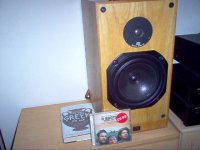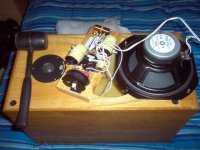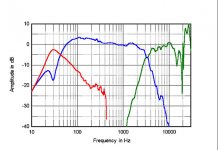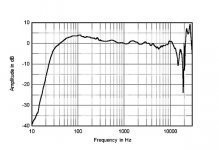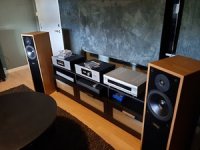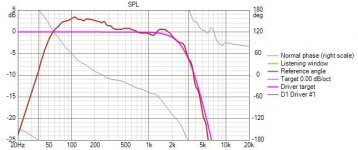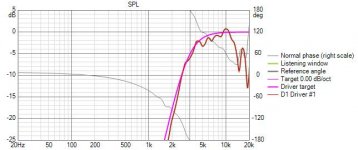great responses TY. My current speaker is 1 MW16P and TW29R and they are very detailed and not very polite so I am trying to teach them manners lol. I agree with what was said about the 30.2. Everything is a trade off.
I second that request @System7 can you take this grasshopper to school ans explain. I understand certain principle but I am unable to connect the dots.
How are the Volt brand polycone drivers for such a Harbeth clone task ?
@Systeme 7 : not sure I understood what you said about the recess and the 90° phase to lower the XO in relation to a third order filter ?
I assume we are talking of horizontal spacing. Should not the bass driver be advanced (and not recessed) for time phase alignement in the crossover overlap, i.e. time center adjustment ? Or are we not talking about delay but frequency range cut off (pardon my ignorance 😱). Is the impulse response alignement of the two drivers affected by the filter order phase delay(90° advance per order?)
I'm wonder also if Harbeth is using BS compensation in their filter ?
Edit : also forget : the poly from SB Acoustic have very low distorsion while perhaps being close to what "plastic" cone do (polite=a little less details?) ? The Rolls-Royce as already said being Audiotechnology drivers while expensive.
if you recess the woofer enough in a BUT18 electrical high pass for say + 90° phase (related to the time center coincident point at cut-off ), do we have a "sorta of BUT24" acoustical high pass ? Better time coincident with the two drivers than a BUT18 in the crossover overlap area ? Or needed to target a 24 dB electrical low pass for the tweeter ?
I"m lost too, not saying I don't know how is the behavior off axis as well (Mabakkk input) ???
I"m lost too, not saying I don't know how is the behavior off axis as well (Mabakkk input) ???
Last edited:
As I recall, Steve often uses 3rd order Butterworth / 'BW3' as a synonym for a crossover that contains a 3rd order electrical filter somewhere (usually the high pass) rather than necessarily always referring to the acoustic slopes.
Sorry, boys, I had hoped this thread was finished by now. But have now installed my cheap Harbeth clones to keep up with things here. And very nice they sound. 🙂
It is hard to know where to start with matters crossover. My current effort, and I just checked, seems to be this.
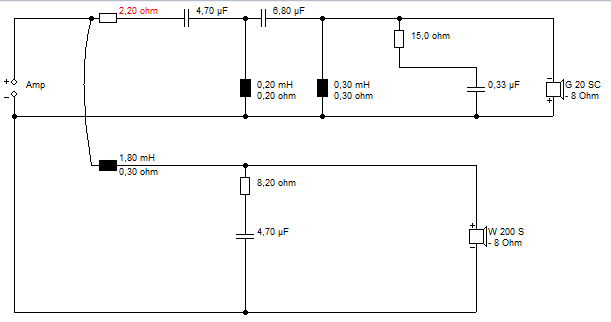
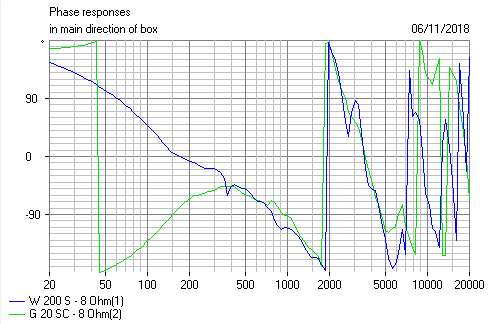
For some reason I forget, I have changed the tweeter resistor 2.2R to 3.9R, but have retained my own invention, the "Half-Zobel" of 15R and 0.33uF. This is a special fix I devised for harsh metal tweeter sound, and I have also removed the tweeter ferrofluid on the advice of forum speaker genius Joachim Gerhard. He says ferrofluid is a bad thing. 🙂
BW3 is a 90 degree solution, which has a subtly different sound:
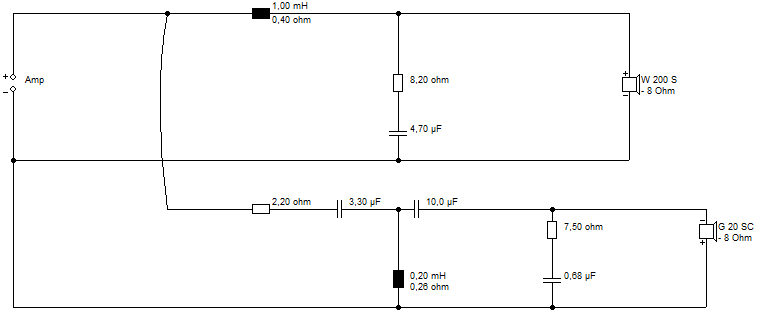
By removing a coil, the phase shifts 90 degrees. Simple as that. Hope everything is clear now. I would seriously consider a SEAS metal tweeter, any one really, because I have a dim view of soft-dome tweeters. As does speaker genius Alan Shaw I think. Add any well-behaved woofer. The cheaper the better, IMO. The rest is just technique. 😎
It is hard to know where to start with matters crossover. My current effort, and I just checked, seems to be this.
For some reason I forget, I have changed the tweeter resistor 2.2R to 3.9R, but have retained my own invention, the "Half-Zobel" of 15R and 0.33uF. This is a special fix I devised for harsh metal tweeter sound, and I have also removed the tweeter ferrofluid on the advice of forum speaker genius Joachim Gerhard. He says ferrofluid is a bad thing. 🙂
BW3 is a 90 degree solution, which has a subtly different sound:
By removing a coil, the phase shifts 90 degrees. Simple as that. Hope everything is clear now. I would seriously consider a SEAS metal tweeter, any one really, because I have a dim view of soft-dome tweeters. As does speaker genius Alan Shaw I think. Add any well-behaved woofer. The cheaper the better, IMO. The rest is just technique. 😎
Attachments
He can't have that dim a view; the M30 & his range-topping M40 variations use a soft dome (a modified Seas T25 Excel). 😉
OK, you're using 'BW3' or '3rd order Butterworth' as a synonym for a 3rd order electrical filter. Technically that's wrong or at least potentially misleading as far as loudspeaker crossovers go, since acoustical and electrical alignments are certainly not synonymous in the majority of situations, but appreciate you clarifying how you're using it as it removes some potential confusion in future.
OK, you're using 'BW3' or '3rd order Butterworth' as a synonym for a 3rd order electrical filter. Technically that's wrong or at least potentially misleading as far as loudspeaker crossovers go, since acoustical and electrical alignments are certainly not synonymous in the majority of situations, but appreciate you clarifying how you're using it as it removes some potential confusion in future.
Last edited:
Thanks Steve,
So LP is a damped second order. HP is a BUT18. You moved the second coil from the previous fourth order HP to match the phase in the 2k hz crossover overlap area. Connecting the HP in positive polarity re add the 90° lost by the removed coil ?
So the even order LP is seing an even order HP (here the summ of electrical + acoustical) ? So the HP will be "only" + 180° from a timing perspective with the LP ?
Haberth in its 30.2 serie model uses the acoustical phase alignement with the recessed woofer and on some model the recessed mid (40.2 3ways serie) ?
As Stereophile is saying the 30.2 is not time or coincident design either what is showing the step response, your at the opposite is phase coincident ? It's the same move phase philosophy with reversing the polarity of one side of the crossover ; 180° shift !
Well sorry off topic. My fault I should do the math... I stikll mix up impulse response alignement à la Bagby for instance with the phases of the filtetr and phases alignement. Certainly two sides of a sames coins but I never found a didactic book to explain this (not so clear to me in Dickasson bestseller). Tyhanks again Steve, I am a slow man.
So LP is a damped second order. HP is a BUT18. You moved the second coil from the previous fourth order HP to match the phase in the 2k hz crossover overlap area. Connecting the HP in positive polarity re add the 90° lost by the removed coil ?
So the even order LP is seing an even order HP (here the summ of electrical + acoustical) ? So the HP will be "only" + 180° from a timing perspective with the LP ?
Haberth in its 30.2 serie model uses the acoustical phase alignement with the recessed woofer and on some model the recessed mid (40.2 3ways serie) ?
As Stereophile is saying the 30.2 is not time or coincident design either what is showing the step response, your at the opposite is phase coincident ? It's the same move phase philosophy with reversing the polarity of one side of the crossover ; 180° shift !
Well sorry off topic. My fault I should do the math... I stikll mix up impulse response alignement à la Bagby for instance with the phases of the filtetr and phases alignement. Certainly two sides of a sames coins but I never found a didactic book to explain this (not so clear to me in Dickasson bestseller). Tyhanks again Steve, I am a slow man.
Last edited:
From a design point of views should those phase (and eventually impulse response) measurements in box should be made on axis or off axis at the listening position when you tune the cabinet or the crossover please ? I beleive to understand BUT18 being acousticaly better (subjectivly?) off-axis.
uuuuuh, my brain is as slow as a running camenbert!
uuuuuh, my brain is as slow as a running camenbert!
Hardly anyone at this forum has the faintest idea what BW3 is. Never mind the equally useful BW5 acoustic slope.
But what I have done here is adjust the filter for a 3dB boost at crossover, and allowed the phase to go to 90 degrees, thus getting flat frequency response on axis, and flatter power response and impedance which is the mark of Butterworth.

No need to measure anything whatsoever. My competent designs work straight out of the box. It is, in fact first order with impedance correction electrically.
I have enough junk in my apartment without buying measuring microphones. I have superbly accurate ears.
Tweeter level should be adjusted to taste, because a flat monitor balance is not to everyone's taste. Some preferring a gentle rolloff on the tweeter, as I do.
KEF used a similar circuit for a very exact 18dB/octave in this complicated looking circuit:
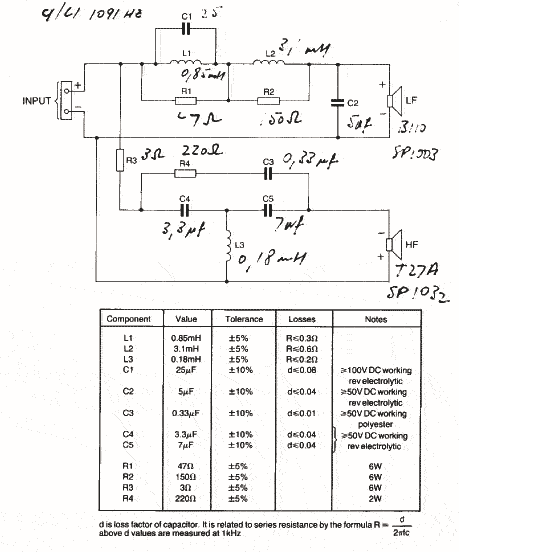
Electrically it looks like this:
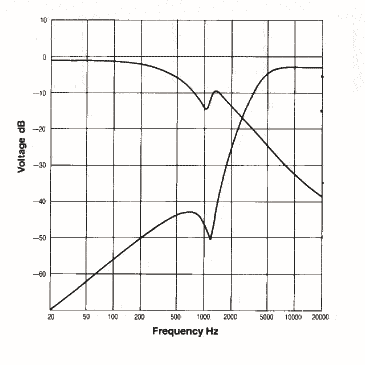
All 18 pages of technical gibberish are to be found ere:
https://us.kef.com/pub/media/pdf/KEFTOPICS_vol4no2_crossover_filters.pdf
I am exactly right in saying Alan Shaw prefers metal tweeters:
SHL5plus XD - Harbeth
He modestly says this is the ULTIMATE British Monitor. That means there is no improvement possible. Consider his soft-dome models strictly for the cloth-eared at the cheaper end of the market.
But what I have done here is adjust the filter for a 3dB boost at crossover, and allowed the phase to go to 90 degrees, thus getting flat frequency response on axis, and flatter power response and impedance which is the mark of Butterworth.
No need to measure anything whatsoever. My competent designs work straight out of the box. It is, in fact first order with impedance correction electrically.
I have enough junk in my apartment without buying measuring microphones. I have superbly accurate ears.
Tweeter level should be adjusted to taste, because a flat monitor balance is not to everyone's taste. Some preferring a gentle rolloff on the tweeter, as I do.
KEF used a similar circuit for a very exact 18dB/octave in this complicated looking circuit:
Electrically it looks like this:
All 18 pages of technical gibberish are to be found ere:
https://us.kef.com/pub/media/pdf/KEFTOPICS_vol4no2_crossover_filters.pdf
I am exactly right in saying Alan Shaw prefers metal tweeters:
SHL5plus XD - Harbeth
He modestly says this is the ULTIMATE British Monitor. That means there is no improvement possible. Consider his soft-dome models strictly for the cloth-eared at the cheaper end of the market.
It's far from conclusive that 3rd order Butterworth is automatically superior off-axis than alternatives. In theory, it has a flat frequency and flat power response, which are certainly good things, although it does have lobes that you need to account for. In practice it's not so simple, because for a start, a good number of designs that are described as such are not, acoustically speaking, running 3rd order Butterworth slopes or phasing at all, making it a bit of a moot point. The example Steve gives above doesn't for instance. QED.
Moreover, not everybody thinks designs that really are running acoustic 3rd order Butterworth slopes sound superior to anything else -Troels Gravesen for example simply stated when designing his Jenzen series that 'The classic 3rd order Butterworth filter is out of the question as I just don't think it sounds good.' Jenzen Speakers And of course, there are the fans of other filter types. These things can be made too much of, and ultimately tend to be about personal preference, mostly based on power-response in the mid and farfields relative to the on-axis, power-handling / distortion performance, and what works for you. Anything beyond that is bordering on mysticism.
Moreover, not everybody thinks designs that really are running acoustic 3rd order Butterworth slopes sound superior to anything else -Troels Gravesen for example simply stated when designing his Jenzen series that 'The classic 3rd order Butterworth filter is out of the question as I just don't think it sounds good.' Jenzen Speakers And of course, there are the fans of other filter types. These things can be made too much of, and ultimately tend to be about personal preference, mostly based on power-response in the mid and farfields relative to the on-axis, power-handling / distortion performance, and what works for you. Anything beyond that is bordering on mysticism.
I hope so, but you might not like this one. 😉 Apologies in advance.
Setting your self-aggrandising aside for a moment, Steve, we'll briefly consider the Harbeth aspect you raise.
Alan Shaw is the owner of a business, not the provider of unbiased factual information about his own product. If the SuperHL5 XD were in reality 'the ULTIMATE British Monitor', perhaps one of you could explain how it is impossible to improve upon the severe destructive interference > 10KHz caused by running twin tweeters through the same frequency range (attached measurements by John Atkinson, averaged over a 30 degree horizontal window. The vertical is even less pretty).
Next:
No doubt you do. However, I always find facts instructive, so it is worth noting for those interested that the two cheapest Harbeth models (specifically, the P3ESR XD and C7ES-3 XD) actually run metal dome tweeters. Current pricing for the three most expensive models (with some variation depending on retailer & finish) is:
Super5HLS XD (metal dome tweeter & supertweeter): from £4,195
M30.2 XD (soft dome Seas T25 Excel derived): from £4,365
M40.2 XD (soft dome Seas T25 Excel derived): from £14,999
Clearly, the M30 & M40 are indeed 'for the cloth-eared at the cheaper end of the market'. He must really dislike soft-domes, given that he's using them in two of his three most expensive models. Including the most expensive by about £10,000, and arguably, the two most expensive depending on retailer & finish.
So. Reverting to the rest, you generously announce that
Which based on your own posts appears to include yourself. A 3rd order Butterworth filter has a specific characteristic: 18dB/ octave slopes and 90 or 270 degree phase relationship between the drivers through the transition band. It is not an euphemism for a filter that contains a 3rd order electrical topology somewhere. Now sure, you can adjust the slopes on one leg or even several (depending on speaker type) to provide some asymmetry if this is necessary to hit the desired alignment, but if none of the drivers are actually rolling off on 18dB slopes and it doesn't conform to 3rd order Butterworth characteristics, describing it as such is simply incorrect.
The simulation you provide above as an example of a 3rd order Butterworth for example actually appears to have both tweeter & woofer rolling off on something closer to 4th order acoustical slopes. It doesn't have a particularly flat power response either, albeit certainly flatter than the simulated example you provided of a 4th order (type unspecified), where the tweeter actually appears to be rolling off approximately 6th order & the woofer somewhere around 5th order. You know well that in crossover design standard practice is to use the acoustical slopes as the reference for type, not the electrical ladder order, since we work with a combination of the electrical filter characteristic and the acoustical slopes of the drivers.
Regarding the KEF filter, despite announcing that your fellow forum members are ignorant, you are not alone in recognising the acoustic Butterworth high pass, which takes a 3rd order Butterworth high-pass filter (electrical and acoustical), and bypasses the capacitors with a series-wired capacitor and resistor, placing a notch at Fs & resulting in a 4th order Butterworth rolloff characteristic to that point, below which it transitions to 2nd order. So if we could dispense with the superiority complex, that would be super. HL5 XD, no doubt. 😉
Setting your self-aggrandising aside for a moment, Steve, we'll briefly consider the Harbeth aspect you raise.
I am exactly right in saying Alan Shaw prefers metal tweeters:
SHL5plus XD - Harbeth
He modestly says this is the ULTIMATE British Monitor. That means there is no improvement possible.
Alan Shaw is the owner of a business, not the provider of unbiased factual information about his own product. If the SuperHL5 XD were in reality 'the ULTIMATE British Monitor', perhaps one of you could explain how it is impossible to improve upon the severe destructive interference > 10KHz caused by running twin tweeters through the same frequency range (attached measurements by John Atkinson, averaged over a 30 degree horizontal window. The vertical is even less pretty).
Next:
Consider his soft-dome models strictly for the cloth-eared at the cheaper end of the market.
No doubt you do. However, I always find facts instructive, so it is worth noting for those interested that the two cheapest Harbeth models (specifically, the P3ESR XD and C7ES-3 XD) actually run metal dome tweeters. Current pricing for the three most expensive models (with some variation depending on retailer & finish) is:
Super5HLS XD (metal dome tweeter & supertweeter): from £4,195
M30.2 XD (soft dome Seas T25 Excel derived): from £4,365
M40.2 XD (soft dome Seas T25 Excel derived): from £14,999
Clearly, the M30 & M40 are indeed 'for the cloth-eared at the cheaper end of the market'. He must really dislike soft-domes, given that he's using them in two of his three most expensive models. Including the most expensive by about £10,000, and arguably, the two most expensive depending on retailer & finish.
So. Reverting to the rest, you generously announce that
Hardly anyone at this forum has the faintest idea what BW3 is.
Which based on your own posts appears to include yourself. A 3rd order Butterworth filter has a specific characteristic: 18dB/ octave slopes and 90 or 270 degree phase relationship between the drivers through the transition band. It is not an euphemism for a filter that contains a 3rd order electrical topology somewhere. Now sure, you can adjust the slopes on one leg or even several (depending on speaker type) to provide some asymmetry if this is necessary to hit the desired alignment, but if none of the drivers are actually rolling off on 18dB slopes and it doesn't conform to 3rd order Butterworth characteristics, describing it as such is simply incorrect.
The simulation you provide above as an example of a 3rd order Butterworth for example actually appears to have both tweeter & woofer rolling off on something closer to 4th order acoustical slopes. It doesn't have a particularly flat power response either, albeit certainly flatter than the simulated example you provided of a 4th order (type unspecified), where the tweeter actually appears to be rolling off approximately 6th order & the woofer somewhere around 5th order. You know well that in crossover design standard practice is to use the acoustical slopes as the reference for type, not the electrical ladder order, since we work with a combination of the electrical filter characteristic and the acoustical slopes of the drivers.
Regarding the KEF filter, despite announcing that your fellow forum members are ignorant, you are not alone in recognising the acoustic Butterworth high pass, which takes a 3rd order Butterworth high-pass filter (electrical and acoustical), and bypasses the capacitors with a series-wired capacitor and resistor, placing a notch at Fs & resulting in a 4th order Butterworth rolloff characteristic to that point, below which it transitions to 2nd order. So if we could dispense with the superiority complex, that would be super. HL5 XD, no doubt. 😉
Attachments
Last edited:
Myself and speaker genius Troels Gravesen have had frequent forum spats about his rapacious commercialisation of what, to me, is merely an interesting hobby in search of a better sound from my affordable projects.
Very little flies past my radar on mention of Hilbert Transforms and Dirac Delta functions!
Troels is currently "upgrading" his commendable free projects in favour of money-spinning LR2 (12dB/octave) and questionable and difficult time-alignment carpentry. 😡
Quite. I am in the business of building "The People's Speaker". Sensible and uncomplicated and cheap design without snake oil or shadows that will satisfy any normal human-being.
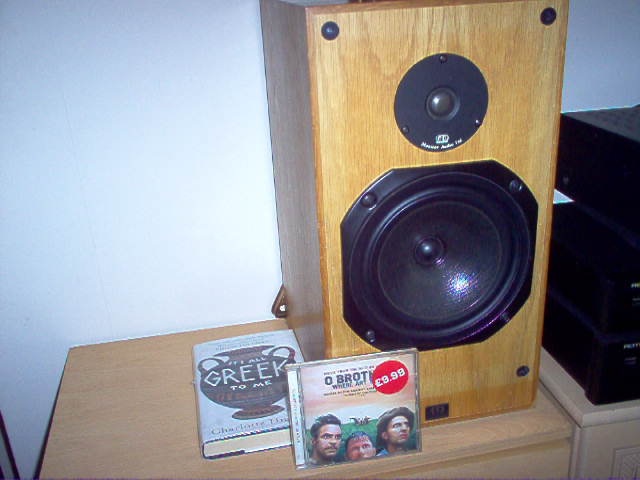
Now apart from his foolish choice of striped shirt on camera, which produces distracting colour fringes, I find no sign of snake oil in Alan Shaw.
Here he is guarded of his secrets with an attractive interviewer who clearly has some technical ability, whilst emphasising the enormous profits he makes out of his customers:
Harbeth на Munich High End 2018 - интервью с Alan Shaw. - Soundex.ru - YouTube
Here he is lured into saying more than he should by an interviewer who clearly wouldn't know BW3 and LR4 from a hole in the ground:
Harbeth Loudspeakers Factory Visit - YouTube
I however was observing his graphs closely, and noticed he uses 15dB/octave on his Radial woofer. None of these people can fool me. I say this modestly. 😱
Very little flies past my radar on mention of Hilbert Transforms and Dirac Delta functions!
Troels is currently "upgrading" his commendable free projects in favour of money-spinning LR2 (12dB/octave) and questionable and difficult time-alignment carpentry. 😡
T.S. Eliot said:Between the idea
And the reality
Between the motion
And the act
Falls the Shadow
-The Hollow Men
Quite. I am in the business of building "The People's Speaker". Sensible and uncomplicated and cheap design without snake oil or shadows that will satisfy any normal human-being.
Now apart from his foolish choice of striped shirt on camera, which produces distracting colour fringes, I find no sign of snake oil in Alan Shaw.
Here he is guarded of his secrets with an attractive interviewer who clearly has some technical ability, whilst emphasising the enormous profits he makes out of his customers:
Harbeth на Munich High End 2018 - интервью с Alan Shaw. - Soundex.ru - YouTube
Here he is lured into saying more than he should by an interviewer who clearly wouldn't know BW3 and LR4 from a hole in the ground:
Harbeth Loudspeakers Factory Visit - YouTube
I however was observing his graphs closely, and noticed he uses 15dB/octave on his Radial woofer. None of these people can fool me. I say this modestly. 😱
What...? no FIR filtering and room correction - but - that is so unmodern 😉😀Quite. I am in the business of building "The People's Speaker". Sensible and uncomplicated and cheap design without snake oil or shadows that will satisfy any normal human-being.
F.I.R. filters were practically invented by my old digital and analog Tutor of matters analog and digital filtering, Tony Constantinides at Imperial College Department of Electrical and Electronic Engineering!
Introduced himself as CONTstanides. But admitted he had been called worse. 😀
How he enjoyed telling us that his arch-rival Professor "Whatshisname" of Gottingen University had published a design for some F.I.R. digital filter to World acclaim. He went on to explain that he had found, to his delight, a glaring Mathematical error in the circuit. 😀
The circuit was UNSTABLE under feedback. Invited us to evaluate the z-transform. Which he had also invented. 😕
How we laughed. Doctor Tony was a sound man before 11 AM. After that sober effort he retired to his favourite bottle of Greek Wine. To which he invited his favourite students to share.
You can't hold down a good man. Now Professor Emeritus. 😎
Introduced himself as CONTstanides. But admitted he had been called worse. 😀
How he enjoyed telling us that his arch-rival Professor "Whatshisname" of Gottingen University had published a design for some F.I.R. digital filter to World acclaim. He went on to explain that he had found, to his delight, a glaring Mathematical error in the circuit. 😀
The circuit was UNSTABLE under feedback. Invited us to evaluate the z-transform. Which he had also invented. 😕
How we laughed. Doctor Tony was a sound man before 11 AM. After that sober effort he retired to his favourite bottle of Greek Wine. To which he invited his favourite students to share.
You can't hold down a good man. Now Professor Emeritus. 😎
Attachments
Here's the dubious SEAS Njord speaker with a regular sort of 1" SEAS tweeter:
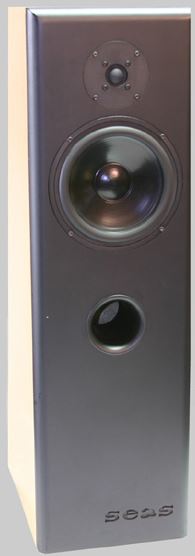
Comes with a crossover a Child of Ten can build:
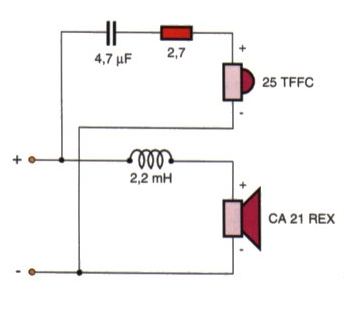
Here's the woofer:
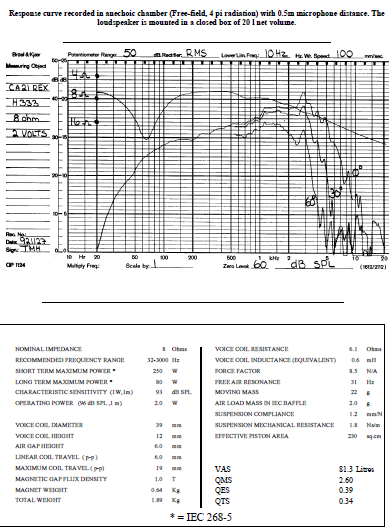
Now experience tells me you are going to hear a lot of woofer breakup and tweeter distortion there.
Now look at the original circuit in my modified Monitor Audio R300-MD, it might be vaguely LR2 on tweeter, but nearer third or 4th order order acoustically:
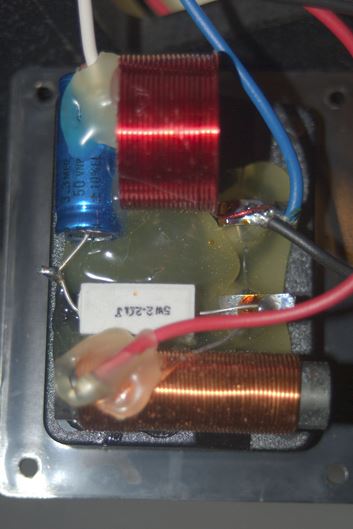
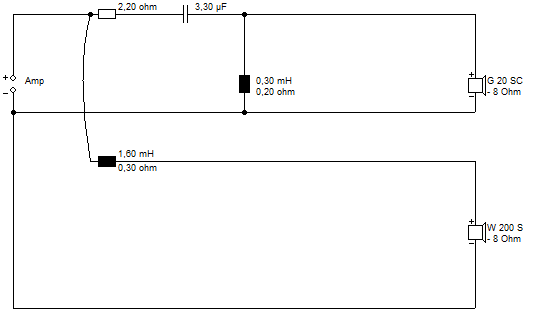
I modelled both of them, and they are horrible on phase and breakup, which occurs around 3.5kHz on 8" woofers. Have got a much cleaner sound from 3rd and 4th order filters. A BBC and Harbeth idea. If you want to do 8" and 1", the third order is easy enough to build and works with most stuff. It's not strictly BW3, but near enough. Where phase goes sideways, it fills the dispersion hole. You can try what you like though. It's your project.
Comes with a crossover a Child of Ten can build:
Here's the woofer:
Now experience tells me you are going to hear a lot of woofer breakup and tweeter distortion there.
Now look at the original circuit in my modified Monitor Audio R300-MD, it might be vaguely LR2 on tweeter, but nearer third or 4th order order acoustically:
I modelled both of them, and they are horrible on phase and breakup, which occurs around 3.5kHz on 8" woofers. Have got a much cleaner sound from 3rd and 4th order filters. A BBC and Harbeth idea. If you want to do 8" and 1", the third order is easy enough to build and works with most stuff. It's not strictly BW3, but near enough. Where phase goes sideways, it fills the dispersion hole. You can try what you like though. It's your project.
I saw Vifa P21 mentioned earlier. I used to hate that driver, dull and uninvolving sound was my experience. But lately I have found new love for this driver. A couple of things I experience is that you must not use too "dead" cabinet, regular fibreboard works great. And use minimal internal damping material. With the super smooth frequency response you can use very simple crossover to hit your target curve.
After trying out some of Steve's "recepies" with Vifa M21, I have found that his BW3 style crossover using 8inch woofer and inverted polarity on tweeter is "my kind of sound".
I bought these old norwegian Patos 401 which use Vifa P21-10-08 and Morel MDT32S tweeters. With a very simple modified 3khz BW3 crossover and inverted polarity on tweeter they sound very, very good.
After trying out some of Steve's "recepies" with Vifa M21, I have found that his BW3 style crossover using 8inch woofer and inverted polarity on tweeter is "my kind of sound".
I bought these old norwegian Patos 401 which use Vifa P21-10-08 and Morel MDT32S tweeters. With a very simple modified 3khz BW3 crossover and inverted polarity on tweeter they sound very, very good.
Attachments
Could not resist to do a bit of curve tracing and overlaying the graphs Scottmoose posted on post 52. If you would like that, I gladly do the hi-pass as well..
This is as 4th order LR acoustic as it gets, no matter what the electric topology or electric transfer function of the filter is....
This is as 4th order LR acoustic as it gets, no matter what the electric topology or electric transfer function of the filter is....
Attachments
- Home
- Loudspeakers
- Multi-Way
- Woofer suggestion for Harbeth like 2 way
